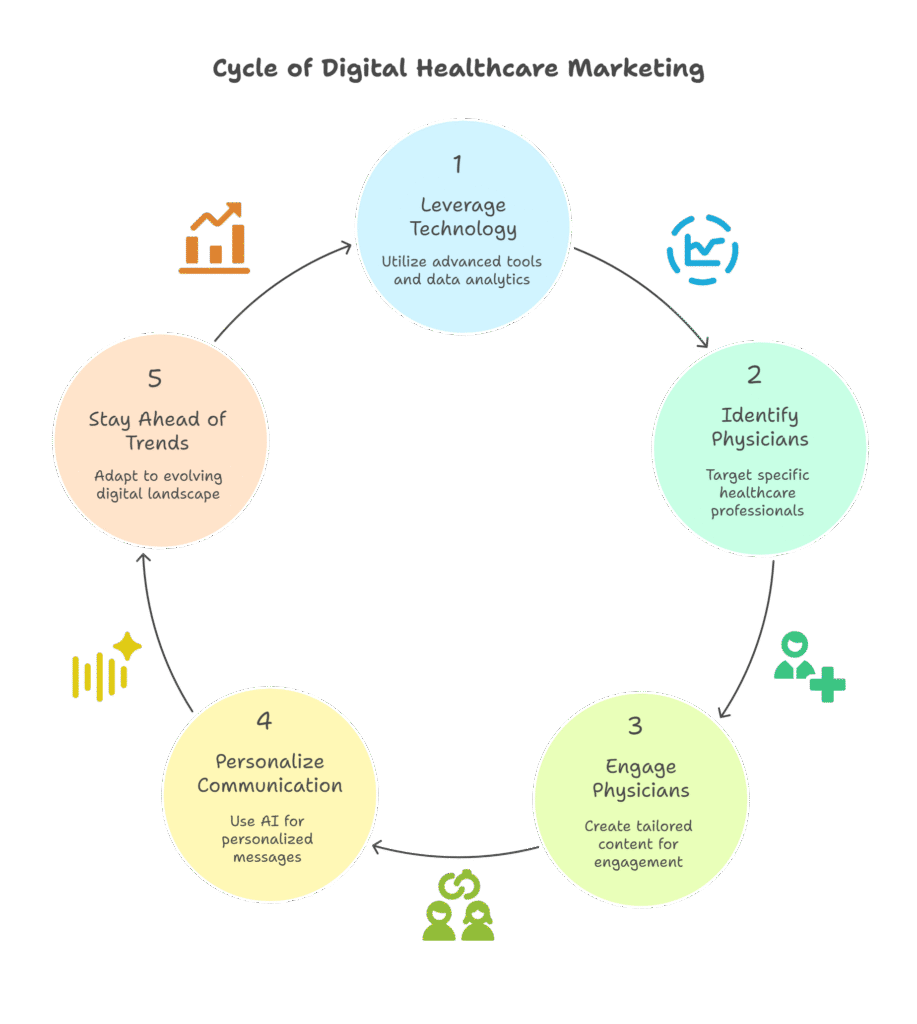
How Healthcare Marketers Reach Physicians Effectively in the Digital Age
In the past decade, in-person access to physicians has dropped by over 50%, while 70% of physicians now use online medical communities and digital resources to inform their clinical decisions. This seismic shift has left many healthcare marketers facing a critical challenge: the old playbook is no longer effective.
Cutting through the digital noise to connect with time-poor, skeptical, and information-saturated physicians requires more than a simple pivot; it demands a fundamental rethinking of how we communicate.
The struggle to effectively reach physicians through traditional means is real, but the opportunity to connect through digital channels is immense.

To succeed in the current landscape, healthcare marketing professionals must pivot from a sales-centric model to a value-driven, digital-first approach.
This involves leveraging physicians’ preferred channels to build trust and facilitate meaningful physician engagement that supports better patient outcomes and builds lasting brand loyalty.
The New Reality of Physician Access
The days of walking into a clinic and easily securing five minutes with a physician are fading fast. The rise of the “no-see” physician phenomenon, driven by tightening schedules and corporate policies, has reshaped the landscape.
Recent industry data shows that fewer than half of all physicians are now considered “rep-accessible,” a stark contrast to a decade ago. This reality necessitates new and more sophisticated medical marketing strategies.
Simultaneously, physicians have become sophisticated digital consumers. Just like other professionals, they turn to digital channels first for research, peer-to-peer connection, and continuing education.
They are active on secure, physician-only platforms like Doximity and Sermo, not for marketing messages, but for clinical collaboration and to stay abreast of the latest research. Understanding this behavior is the first step toward building a successful engagement strategy.
Crafting a Value-First Content Strategy
In an environment of information overload, promotional content is tuned out. To truly capture a physician’s attention, you must move beyond the digital brochure and provide tangible value that helps them do their job better.
The core of any modern digital marketing for pharma or medical device campaign must be content that educates, informs, and assists.
The pillars of a high-value content strategy include:
- Educational Resources: Offer accredited Continuing Medical Education (CME) opportunities, provide concise summaries of new clinical trial data, or host on-demand webinars with respected Key Opinion Leaders (KOLs). This content positions your brand as a valuable educational partner.
- Clinical Utility Tools: Develop practical digital tools that physicians can use in their daily workflow. This could include interactive dosing calculators, downloadable patient resource kits, or easy-to-reference diagnostic guides. These tools create recurring engagement and embed your brand in the clinical process.
- Peer-to-Peer Insights: Physicians trust their peers above all else. Facilitate this by sharing anonymized case studies, hosting expert-led panel discussions, or amplifying content from trusted medical influencers within their specialty.
A powerful example of this in action is a medical device company that created a non-branded educational web portal dedicated to a complex new surgical technique.
By providing high-quality videos, expert tutorials, and peer-reviewed articles, they became the go-to resource for surgeons learning the procedure, building immense trust and brand preference without a single overt sales pitch.
Key Channels for Effective Physician Outreach
A value-driven content strategy is only effective if it reaches its intended audience. A multi-channel approach is essential for effective physician outreach, meeting physicians where they are already active.
- Professional Medical Networks: Platforms like Doximity and Sermo offer an unparalleled opportunity for compliant and targeted messaging within a trusted, peer-reviewed environment. Advertising here allows for precise targeting by specialty, geography, and interest, ensuring your valuable content is seen by the right clinicians.
- Medical Journals and Publications: Physicians still rely on trusted publications like the New England Journal of Medicine (NEJM) or The Lancet for critical updates. Placing well-crafted digital advertisements in the online versions of these journals aligns your brand with clinical excellence and credibility.
- Email Marketing, Perfected: While inboxes are crowded, a personalized and relevant email is still a powerful tool. Industry data shows that physician-targeted emails can achieve open rates of 20-25% when executed properly. Best practices include sharp segmentation by specialty, mobile-first design, and a clear, concise message that immediately demonstrates value – such as an invitation to a KOL webinar or a link to newly published clinical data.
- Search Engine Marketing (SEM): When a physician needs a quick answer to a clinical question, they turn to Google. A targeted SEM strategy allows you to place your resources at the top of the search results for highly specific, long-tail keywords related to diagnostics, treatments, and product comparisons, capturing their attention at the exact moment of need.
Measuring Success and Ensuring Compliance
To prove the effectiveness of your digital strategy, you must track metrics that go beyond impressions and clicks. The KPIs that truly matter in healthcare marketing reflect genuine engagement.
Measure the number of webinar sign-ups, the time spent on a page with clinical data, downloads of patient resources, or digital requests for samples. These metrics provide clear evidence of impact and a tangible ROI.
Of course, all these activities must be executed within a strict regulatory framework. Ensuring that all medical marketing strategies are fully compliant with regulations like HIPAA and the Sunshine Act is not just a legal requirement – it is foundational to building and maintaining physician trust. Transparency and ethical conduct are non-negotiable.
Final Thoughts
The methods used to reach physicians have been irrevocably transformed. The modern approach is no longer about selling; it is about serving.
Success requires a deep, empathetic understanding of physician needs, an unwavering commitment to providing clinical value, and a sophisticated, multi-channel digital strategy that respects their time and intelligence.
The future of effective healthcare marketing lies in building authentic, trust-based relationships through credible, useful, and easily accessible digital content. By making this fundamental shift, you can not only reach physicians but also become their trusted partner in improving patient care.